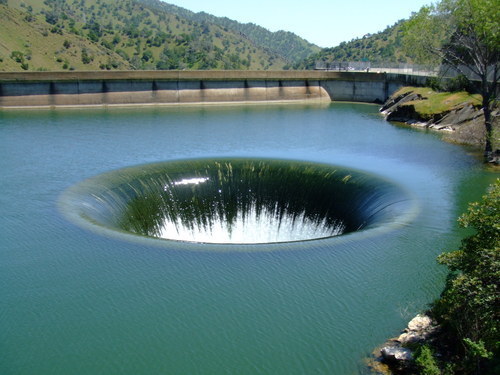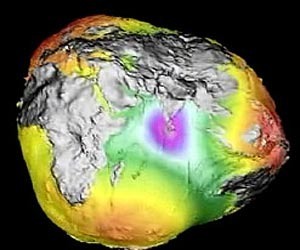Gravity Sucks
 Recently, Jupiter was hit by a comet/asteroid that would have made the Chicxulub impact that wiped out the dinosaurs look like a pebble landing in a pond.
Recently, Jupiter was hit by a comet/asteroid that would have made the Chicxulub impact that wiped out the dinosaurs look like a pebble landing in a pond.
In talking about this with a colleague, the concept of gravitational wells came up, in particular the concept that Jupiter acts as a vacuum cleaner in our solar system, mopping up debris and protecting life on Earth from big impacts. In fact, a Jupiter-like planet may be a prerequisite for life elsewhere in the universe; think of Jupiter as a celestial bouncer making sure no one gate-crashes the party.
To help visualise this, I thought it would be fun to post a blog about what it would be like to wear a pair of “gravitational lenses” and see the solar system from a gravitational perspective.
If you think about Earth and what it looks like from space, you probably get a mind picture similar to the image above, but, from a gravitational perspective, the Earth isn’t quite so uniform and pretty, looking a bit more like something out of the Hunchback of Notre Dame.
The distortions in this image have been exaggerated, but they highlight the different gravitational variations found on Earth. These variations arise from differences in the thickness and composition of Earth’s crust, as well as how plates move relative to each other, subduction zones, the rise of mountains, depths of the sea, etc.
To complicate things further, the gravitational profile of Earth isn’t static as the Sun and Moon also play a part, flexing not only the tides in the sea, but the Earth’s crust as well. Remarkably, the gravitational attraction of the Moon causes the Earth’s crust to rise up to a foot along with high tides.
Space is unimaginably big, so much so we tend to underestimate just how vast distances are in space. We have no terrestrial basis for comparison, making the orders of magnitude difficult to comprehend when thinking about Earth, the Moon, Mars, our solar system, local stars, the Milky Way and the universe as a whole. Putting a man on Mars, as an example, seems easy. We put rovers there all the time. We put men on the Moon forty years ago. How hard can it be to get men and women to Mars? And the answer is, it is absurdly difficult. Getting to Mars isn’t just a matter of willpower, there are serious technical and logistical challenges in operating at that distance. NASA recently likened the Curiosity landing to hitting a golf ball from Los Angeles and achieving a hole in one in Scotland. Don’t underestimate just how incredible it is that Curiosity is driving around Gale Crater. It’s a technical feat beyond that of Stonehenge or the Pyramids.
Every pretty picture you’ve seen of the solar system is grossly distorted by non-linear scaling, and this one is no exception.
If we use a bowling ball to represent the Sun, then you’ll find the planets at the following distances from the bowling ball:
Mercury – a pin-head some 9 meters away
Venus – a peppercorn at 17 meters
Earth – another peppercorn at 24 meters
Mars – a pin-head at 36 meters
Jupiter – a golf ball or Macadamia nut in its shell set out at 120 meters
Saturn – a Macadamia kernel at 225 meters
Uranus – a coffee bean at 453 meters
Neptune – another coffee bean at just over 700 meters
Pluto – a full-stop at just over 900 meters
In between and all around there’s an awful lot of empty space. Well, “empty” is a misnomer, but there’s nothing of any substance beyond a wispy vacuum with highly energetic particles, electromagnetic radiation and the odd rock or stray clump of ice.
We tend to think of the solar system as flat because the planets orbit (mostly) on the same plane, being formed from an accretion disc billions of years ago, but, if we look at the gravitational distortion of the sun and planets we get a very different picture.
This representation of the gravitational wells surrounding the Sun and Jupiter gives us an entirely different view of space, dispelling the notion that space is flat. By the way, the spike in front of the Jupiter well is a Lagrange point, a gravitationally neutral point, where the strength of both gravity wells is effectively cancelled out.
It’s this gravity well surrounding our Macadamia-nut-Jupiter that vacuums up most of the debris that would devastate life on Earth.
XKCD put together the following infographic that highlights, among other things, why the Apollo mission to the moon required a huge Saturn V rocket one way, but only a small rocket for the return journey. (Click on the image to enlarge it and make it easier to read)
Dam “plugholes” are a good example of how a gravity well works, with the currents and the flow of water from all around a dam being influenced in one way or the other by the drain. Get too close and down you go.

In my novel Galactic Exploration the star ship Rift Valley encounters sinister aliens in a dense star cluster and uses the complex gravitational wells and Lagrange points to sail through the cluster as the crew try to escape their pursuers. From a gravitational perspective, the star cluster would have looked something like this, with each of the stars and super-jupiter planets being the long spikes reaching downward.










